Royalist Mint Casting Stamps
by Max A. Keech
Royalist mint casting issues include coinage from Chihuahua and Monclova in the north and from Oaxaca in the south. As previously described, the Royalist authorities needed coinage to pay for troops and supplies but could not get silver to and coinage back from Mexico City because Insurgents held the roads. Therefore, with Mexico City’s authority, they cast their own coinage.
Chihuahua 1811 – 1813
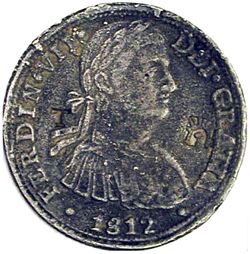
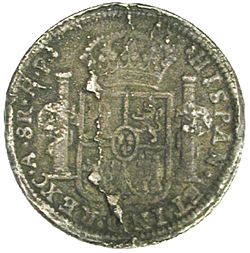
The cast 1811-1813 Chihuahua coinage is based on a Mexico City host, altered for date and mint mark. It has two applied mint casting stamps: a “T” for Treasurer and one depicting the crowned pillars of Hercules with a pomegranate between them.
Unlike Monclova and Oaxaca, the Chihuahua mint continued to operate in the post-1814 period by striking coins of the proper draped bust variety. The 1815-1822 coinage was struck over earlier cast issues of Chihuahua and Monclova as these cast coins were withdrawn from circulation. Evidence of the earlier mint casting stamps of Chihuahua and Monclova will normally show thru on the overstruck coins.Sometimes the underlying stamp can be quite bold giving the impression that the stamp is on a post 1814 issue. Don’t be fooled. Krause list Chihuahua counterstamps from 1815-1822 by misinterpreting the Chihuahua overstruck issues where the underlying mint casting stamp is clearly visible.
Monclova 1811 – 1812
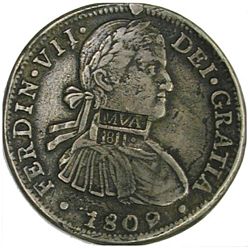 The Monclova mint produced a cast coin, using Mexico City hosts and applying a mint casting stamp with the initials “MVA” and date. Krause catalogs this issue as a counterstamp even though it is a mint issue with a mint casting stamp applied before the coinage entered circulation. This issue has a plain edge.
The Monclova mint produced a cast coin, using Mexico City hosts and applying a mint casting stamp with the initials “MVA” and date. Krause catalogs this issue as a counterstamp even though it is a mint issue with a mint casting stamp applied before the coinage entered circulation. This issue has a plain edge.
After 1814 the Monclova issues were recalled and often used as planchets for striking coins in Chihuahua. Hopefully it is clear to the reader at this point that any post-1812 issues showing an MVA stamp are overstruck on a Monclova host... Ignore KM#201 which miscatalogs these overstrikes as a Chihuahua coin with a Monclova counterstamp.
Oaxaca 1812
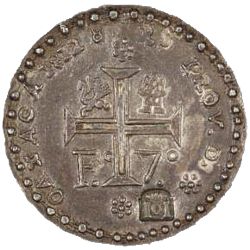
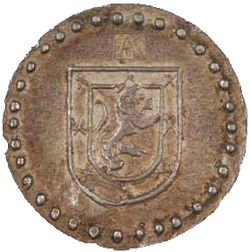
Oaxaca 1812 cast 8 reales
In Oaxaca the Royalists created their own ‘madre’ (mother coin used to cast molds) with a cross on one side and a shield and lion on the other. This had two mint stamps: a crowned “O” between two columns on the obverse and an initial above the shield on the reverse. An edge was placed on the coin after casting.
This is a well-executed cast coinage that virtually all catalogs and collectors recognize as a provisional issue rather than a counterstamp. It should also be recognized as a mint casting stamp with the same fundamentals as the 1811-1813 cast issues of Chihuahua and Monclova.
